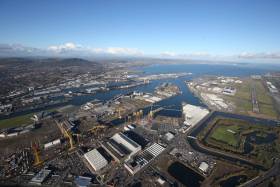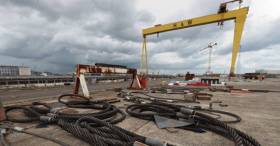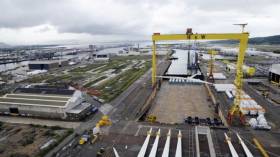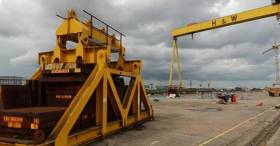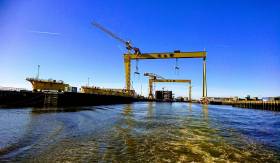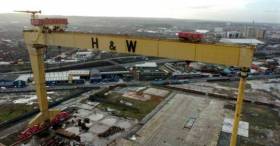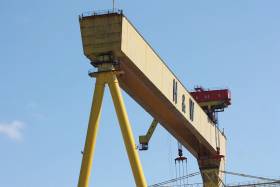Displaying items by tag: Harland & Wolff
Belfast Shipyard Harland & Wolff Receives Non-Binding Offers
Administrators of the Harland and Wolff shipyard, reports BBC News, say they have received a number of non-binding offers to buy the business as a going concern.
The yard, best known for building the Titanic, was placed into administration earlier this month.
Administrators, BDO, said there are other interested parties which may result in further offers.
BDO has agreed with the unions to extend the unpaid temporary lay-off of staff until 30 September.
For more on this latest development at the east Belfast yard, click here.
Administrators at Harland & Wolff Won't Confirm ‘Credible’ Bids for Belfast Shipyard
Two "credible" bids, reports Belfast Telegraph, have now been received for the stricken shipyard Harland & Wolff, it's been claimed.
DUP leader Arlene Foster and the party's East Belfast MP Gavin Robinson made the claim following a meeting with business advisors BDO, who were appointed administrators two weeks ago.
However, BDO would not confirm whether two bids were now on the table, nor the identity of any firms behind the bids.
Harland & Wolff has been facing financial difficulties following a downturn in business and the bankruptcy of its Norwegian parent company Dolphin Drilling, formerly Fred Olsen Energy. And most of its 123 staff have been occupying the site for around four weeks as they repeat calls for the UK Government to renationalise the business.
Mr Robinson said he and Mrs Foster had held a "positive" meeting with the administrators.
The newspaper has more here to read on this ongoing story.
The administrators for Harland & Wolff have extended the temporary unpaid lay-off of workers in what a trade union said was a "light at the end of the tunnel" for the stricken shipyard.
As the Belfast Telegraph reports, business advisers BDO said they had agreed with trade unions that the majority of the 123 staff would continue their temporary lay-off - a move which staves off redundancy.
Staff have been holding a sit-in at the yard as unions called for renationalisation, although the Government has said its difficulties are a commercial issue.
Potential buyers had until midday yesterday (Thursday) to make an offer but the deadline has now been extended. Administrators said they hoped expressions of interest could translate into a viable offer .
East Belfast MP Gavin Robinson said: "This is welcome news and is a demonstration of the ongoing work to secure a positive outcome for the shipyard."
Mr Robinson added he was talking to government about how it could help the shipyard and would also meet the administrator with his party leader Arlene Foster on Monday.
Clikc here for more on the story
'Positive Talks' Over Harland & Wolff Shipyard Future
"Positive discussions" have been held regarding the sale of Belfast shipyard Harland and Wolff, according to the administrators.
The business, BBC News reports, entered administration earlier this month, with accountancy firm BDO overseeing the process.
The move places 120 jobs at risk and could spell the end of the firm, best known for building the Titanic.
BDO said it hoped the ongoing talks may lead to "credible offers".
"In light of this, the administrators, in tandem with the unions and workforce, are intending to continue the unpaid temporary lay-off initiated on our appointment beyond today," it added.
"The limited retained team of workers are continuing to maintain the site and assist the administrators in carrying out their duties."
More can be read here on this story.
A trade union, writes Belfast Telegraph, the GMB has said it's in talks with the administrators of Harland & Wolff about extending the temporary lay-off of staff beyond Friday, it has emerged.
GMB and the Unite union last week reached agreement with business advisers BDO, who were appointed administrators to the stricken shipyard last week, that workers would be laid-off temporarily in a move to stave off redundancy.
Unions have called for renationalisation of the firm, which was previously in government ownership in the 1980s and 1990s.
Yesterday Michael Mulholland of the GMB told the Belfast Telegraph the union is now in talks with the administrators about extending the lay-off, though no agreement has yet been reached.
More on the story can be read here.
Thinking 'Outside the Box' Required to Save Harland & Wolff Says Former N.I. Minister
The Belfast Telegraph writes of a former Northern Ireland minister that has said Secretary of State Julian Smith must "think outside the box" to try and save Harland and Wolff shipyard.
The iconic Belfast company entered administration last week after a period of financial difficulty.
Labour peer Angela Smith was responsible for classifying Harland and Wolff's cranes as "scheduled monuments" while working in the Northern Ireland office, where she served from 2002 to 2006.
The move meant that the landmark cranes could not be removed without government permission.
Baroness Smith serves in the Labour shadow cabinet alongside her role in the House of Lords.
For further reading on this story click this link.
Harland & Wolff: Call for Former Staff to Return to Shipyard on Sunday Part of Campaign to Save Jobs
Retired and former Harland and Wolff workers, writes Belfast Telegraph, have been invited to return to the shipyard on Sunday as part of a special event.
Concrete prints will be made of the "hands that built the shipyard" during an event at 12pm.
Unite shop steward at the shipyard Joe Passmore said that the event is part of the staff occupation in an effort to save jobs, with Harland and Wolff entering administration earlier this week.
“The gesture of concrete hand prints is a testament to the people who built this great industry. The yard means so much to this city and beyond, it needs to be re-nationalised," Mr Passmore said.
We need to take ownership. All hands on deck - let’s save our shipyard."
To read more including what trade union UNITE had to say click here.
Belfast Shipyard: Bidders Express Interest in Buying Harland and Wolff, Administrators Confirm
Potential bidders, reports Belfast Telegraph, have expressed an interest in buying Harland and Wolff, administrators have confirmed.
Insolvency experts Brian Murphy and Michael Jennings from business advisory firm BDO are now running the business.
On Wednesday the majority of the 123 staff have been able to opt for temporary lay-offs, a move which maintains their employment contracts. However, some have already opted for redundancy.
A spokesperson for BDO said on Friday: "In light of insufficient funds to cover the current running costs of the business and in the absence of any other funds being available at this point, in conjunction with Unions, the administrators have agreed to facilitate an unpaid temporary lay-off until Friday 16th August.
The newspaper here has more on the story.
Belfast Shipyard Harland & Wolff Enters Formal Administration
BBC News reports that Harland and Wolff has entered administration, with accountancy firm BDO formally appointed to oversee the Belfast shipyard.
Having employed more than 30,000 at its peak, the move could now put 120 jobs at risk and spell the end of the iconic firm, best known for building the Titanic.
Unions representing workers have called for the shipyard to be renationalised.
They argue it would be cheaper for the government to keep the shipyard open.
However, the government has said the crisis is "ultimately a commercial issue".
The Northern Ireland Office said NI Secretary Julian Smith "understands the impact" uncertainty over the shipyard will have for workers and their families.
It said Mr Smith "had made it clear that he will continue to do everything he can to secure the future of this historic site and ensure workers' interests are protected".
More here on this development at the Queen's Island shipyard.
Harland and Wolff’s Norwegian majority owner has announced it will file for bankruptcy — but the Belfast shipyard says business will continue as usual, as the Belfast Telegraph reports.
The move comes after Dolphin Drilling ASA, formerly Fred Olsen Energy, says it failed to reach a deal with its creditors.
Harland and Wolff, which in recent years has diversified from shipbuilding to the renewable energy sector, is expected to be sold this year as part of its parent company’s restructuring plan.
A spokesperson for Harland and Wolff Heavy Industries Ltd said: “The announced developments in relation to DDASA are not expected to impact this sales process and we are operating very much on a business as usual basis.”
The Belfast Telegraph has more on the story HERE.



























